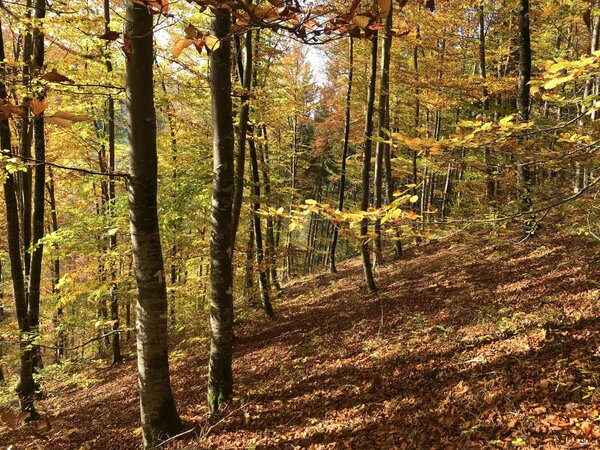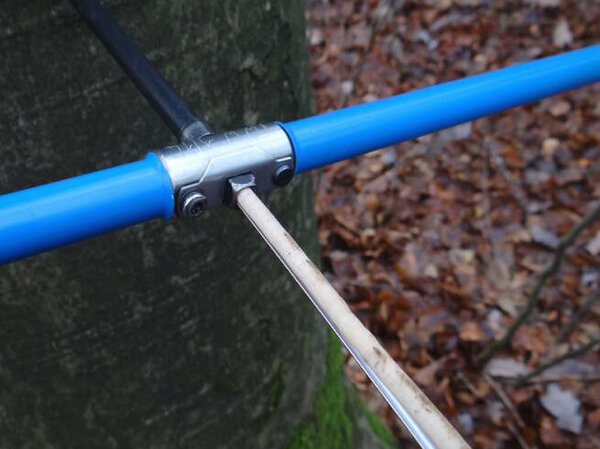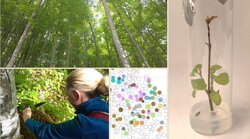Expertise
Leaving the stress behind: Can beech adapt to climate change?
Pascal Eusemann, Katharina Liepe and Niels Müller | 26.01.2023
Beech is suffering from the increasing drought in Germany. Researchers at the Thünen-Institute are studying how it copes with drought stress and how its adaptation to climate change can be supported.
Germany is beech country. In most of Germany's forest areas, European beech would be the main tree species under natural conditions. Only in the driest areas, on the wettest sites or in the coldest locations does it have to give way to other trees. At least, that's how it was until recently. However, the drought summers from 2018 onward have also taken their toll on beech. Almost everywhere in Germany, it has suffered significantly, as the last forest condition surveys demonstrated.
It was not generally unexpected that drier and hotter summers would cause problems. After all, beech is a tree species of the temperate, oceanic climate. It enjoys cool, rainy summers and mild winters and needs sufficient water and precipitation throughout the year. Nevertheless, it was a surprise to see how quickly and how severely beech forests were damaged in just a few years.
It is therefore of utmost importance to better understand the resilience and adaptability of beech to drought stress. For it depends on this how widespread it will be in the future and how threatened it is in its function as the economically and ecologically most important deciduous tree species in Germany.
Unfortunately, resistance to drought stress is a difficult trait, because it is subject to a wide range of influences. The ability to cope with drought stress can already differ greatly between individual trees of the same population due to differences in their genetic setup. In addition, populations in different regions of the European distribution range differ significantly from each other. Beech trees in warmer and drier regions have been better adapted to drought through evolution than those in cool and humid regions. But the environment also has a significant influence. For example, the density of a beech forest or local differences in soil composition determine how well individual trees can cope with drought.
In order to separate these many different and mutually influencing factors and specifically investigate the genetic component of drought stress tolerance, which is important for adaptation to climate change, scientists from the Thünen-Institute, the University of Freiburg and the Technical University of Dresden are approaching the question from several angles simultaneously.
How large is the contribution of genetics and environment on drought stress tolerance?
This question is tackled in an extensive beech forest in the Swabian Jura. First, the relationship of all trees is determined in several carefully selected plots. This is done using the same methods that are used for paternity analyses in humans. Subsequently, tree cores are taken from the trunk. Within the annual rings, these contain information on the growth of a tree throughout its entire life. They can be used to determine how each beech tree responded to environmental conditions in each year of its life and how well it coped with particularly warm and dry years.
Relatedness and drought stress tolerance can then be considered together to determine whether trees within a family are more similar in their drought stress tolerance than unrelated trees. This way, the heritable influence of genes on drought resistance can be separated from the more randomly distributed influence of the environment.
How is resistance to drought stress distributed across the range of beech?
In order to investigate differences between beech trees from different areas of the European distribution range, so-called provenance trials are used. In these trials, beech trees from different parts of the distribution area are collected and cultivated under identical environmental conditions. This makes it possible to compare the trees directly with each other and find out whether the differences observed in nature are genetic or caused by the environment at the original place of origin. Provenance trials can be further improved by planting and comparing beech trees from the same areas of origin on several plots under different environmental conditions.
Beech trees from 30 different areas of origin from all over Europe are grown together on three plots in Schleswig-Holstein, Hesse and Baden-Württemberg. Using these plants, traits responsible for resistance to drought stress can be recorded and directly compared with each other. In addition to the tree cores already mentioned, leaf characteristics are also examined here. Through this investigation, the drought stress tolerance of beech can be compared between different populations from throughout its entire range.
Which genes are responsible for beech's resistance to drought?
A third approach wants to know exactly which genes are responsible for resistance to drought stress. To do this, the scientists are again using provenance trials. In this specific trial, beech trees are grown from more than 100 regions throughout Europe.
By comparing how all these differently adapted trees, now growing under identical environmental conditions, react to drought stress, it is possible to identify the individual genes involved in this reaction. To do this, of course, you need to know all of the beech's genes. Therefore, the entire genome, i.e. the totality of all genes, of all the beech trees studied must be completely decoded. In addition, a sufficiently large number of trees must be studied. Only then can the presumably numerous genes involved, each with only a small influence on the tree's resistance to drought, be reliably determined.
These three approaches, each quite different in its approach, will allow a very precise understanding of how beech copes with drought. The scientists hope that this will shed light on how well our beech forests can adapt to climate change on their own and how this adaptation can be supported by the targeted selection and propagation of particularly well-adapted trees and populations.









